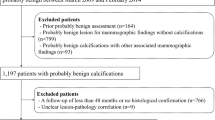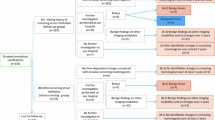Abstract
Objectives
To evaluate the positive predictive values (PPVs) of calcifications with suspicious morphology by incorporating distribution and clinical factors in two separate cohorts to provide more practical guidance for management.
Methods
This retrospective study included 1076 consecutive women from two cohorts (cohort A, 556; cohort B, 520), with calcifications of suspicious morphology seen on mammography that were pathologically confirmed or followed with mammography. Reader-averaged PPVs of the calcifications were analyzed and compared by logistic regression using the generalized estimating equation. Multivariate logistic regression analysis was performed to evaluate independent factors associated with the PPVs of suspicious calcifications.
Results
Overall reader-averaged PPVs of suspicious calcifications were 16.8% and 15.2% in cohort A and B, respectively. Reader-averaged PPVs according to morphology in cohort A and B were as follows: amorphous 9.1%, 6.4%; coarse heterogeneous 16.1%, 22.1%; fine pleomorphic 78.8%, 44.7%; and fine linear branching 78.6%, 85.1%, respectively (p < 0.001). PPVs for diffuse amorphous combinations were 2.6% and 2.6%, and for regional amorphous calcifications, 3.6% and 3.1%, respectively. Among diffuse amorphous calcifications, the PPVs for women ≥ 50 years and women without a personal history of breast cancer ranged from 0.0 to 1.9%.
Conclusions
Amorphous calcifications have lower reader-averaged PPVs compared to calcifications with other suspicious morphology, falling into the BI-RADS 4a assessment (PPV 2–10%). Amorphous calcifications with diffuse distributions detected in women > 50 years old and without a personal history of breast cancer have reader-averaged PPVs < 2.0%. Further prospective studies are necessary to confirm if these patients can be managed with imaging follow-up.
Key Points
• In two cohorts, reader-averaged positive predictive values (PPVs) for suspicious calcifications showed lower rates for amorphous calcifications.
• In two separate cohorts, reader-averaged PPVs showed lower rates for diffuse amorphous calcifications, falling into the BI-RADS 4a assessment category (PPV 2–10%).
• Diffuse amorphous calcifications detected in women > 50 years old and without a personal history of breast cancer have reader-averaged PPVs < 2.0%.

Similar content being viewed by others
Abbreviations
- ACR BI-RADS:
-
American College of Radiology Breast Imaging Reporting And Data System
- ADH:
-
Atypical ductal hyperplasia
- ALH:
-
Atypical lobular hyperplasia
- CI:
-
Confidence interval
- DCIS:
-
Ductal carcinoma in situ
- FEA:
-
Flat epithelial atypia
- IDP:
-
Intraductal papilloma
- LCIS:
-
Lobular carcinoma in situ
- OR:
-
Odds ratio
- PPV:
-
Positive predictive value
References
Rauch GM, Hobbs BP, Kuerer HM et al (2016) Microcalcifications in 1657 patients with pure ductal carcinoma in situ of the breast: correlation with clinical, histopathologic, biologic features, and local recurrence. Ann Surg Oncol 23:482–489
Tabar L, Tony Chen HH, Amy Yen MF et al (2004) Mammographic tumor features can predict long-term outcomes reliably in women with 1-14-mm invasive breast carcinoma. Cancer 101:1745–1759
Thurfjell E, Thurfjell MG, Lindgren A (2001) Mammographic finding as predictor of survival in 1-9 mm invasive breast cancers. worse prognosis for cases presenting as calcifications alone. Breast Cancer Res Treat 67:177–180
Zunzunegui RG, Chung MA, Oruwari J, Golding D, Marchant DJ, Cady B (2003) Casting-type calcifications with invasion and high-grade ductal carcinoma in situ: a more aggressive disease? Arch Surg 138:537–540
American College of Radiology (2013) ACR BI-RADS atlas: breast imaging reporting and data system, 5th edn. American College of Radiology, Reston
Bent CK, Bassett LW, D'Orsi CJ, Sayre JW (2010) The positive predictive value of BI-RADS microcalcification descriptors and final assessment categories. AJR Am J Roentgenol 194:1378–1383
Berg WA, Arnoldus CL, Teferra E, Bhargavan M (2001) Biopsy of amorphous breast calcifications: pathologic outcome and yield at stereotactic biopsy. Radiology 221:495–503
Bernardi D, Borsato G, Pellegrini M et al (2012) On the diagnostic accuracy of stereotactic vacuum-assisted biopsy of nonpalpable breast abnormalities: results in a consecutive series of 769 procedures performed at the Trento department of breast diagnosis. Tumori 98:113–118
Liberman L, Abramson AF, Squires FB, Glassman JR, Morris EA, Dershaw DD (1998) The breast imaging reporting and data system: positive predictive value of mammographic features and final assessment categories. AJR Am J Roentgenol 171:35–40
Kim SY, Kim HY, Kim EK, Kim MJ, Moon HJ, Yoon JH (2015) Evaluation of malignancy risk stratification of microcalcifications detected on mammography: a study based on the 5th edition of BI-RADS. Ann Surg Oncol 22:2895–2901
Oligane HC, Berg WA, Bandos AI et al (2018) Grouped amorphous calcifications at mammography: frequently atypical but rarely associated with aggressive malignancy. Radiology 288:671–679
Iwase M, Tsunoda H, Nakayama K et al (2017) Overcalling low-risk findings: grouped amorphous calcifications found at screening mammography associated with minimal cancer risk. Breast Cancer (Auckl) 24:579–584
Youk JH, Gweon HM, Son EJ, Eun NL, Choi EJ, Kim JA (2019) Scoring system to stratify malignancy risks for mammographic microcalcifications based on breast imaging reporting and data system 5th edition descriptors. Korean J Radiol 20(12):1646–1652
Burnside ES, Ochsner JE, Fowler KJ et al (2007) Use of microcalcification descriptors in BI-RADS 4th edition to stratify risk of malignancy. Radiology 242:388–395
Barnhart HX, Williamson JM (2002) Weighted least-squares approach for comparing correlated kappa. Biometrics 58:1012–1019
Berg WA, Campassi C, Langenberg P, Sexton MJ (2000) Breast imaging reporting and data system: inter- and intraobserver variability in feature analysis and final assessment. AJR Am J Roentgenol 174:1769–1777
Lazarus E, Mainiero MB, Schepps B, Koelliker SL, Livingston LS (2006) BI-RADS lexicon for US and mammography: interobserver variability and positive predictive value. Radiology 239:385–391
Youk JH, Son EJ, Kim J et al (2012) Scoring system based on BI-RADS lexicon to predict probability of malignancy in suspicious microcalcifications. Ann Surg Oncol 19:1491–1498
Lee AY, Wisner DJ, Aminololama-Shakeri S et al (2017) Inter-reader variability in the use of BI-RADS descriptors for suspicious findings on diagnostic mammography: a multi-institution study of 10 academic radiologists. Acad Radiol 24:60–66
Rominger M, Wisgickl C, Timmesfeld N (2012) Breast microcalcifications as type descriptors to stratify risk of malignancy: a systematic review and meta-analysis of 10665 cases with special focus on round/punctate microcalcification. Rofo 184(12):1144–1152
Jackman RJ, Marzoni FA Jr, Rosenberg J (2009) False-negative diagnoses at stereotactic vacuum-assisted needle breast biopsy: long-term follow-up of 1,280 lesions and review of the literature. AJR Am J Roentgenol 192:341–351
Funding
The authors state that this work has not received any funding.
Author information
Authors and Affiliations
Corresponding author
Ethics declarations
Guarantor
The scientific guarantor of this publication is Jung Hyun Yoon.
Conflict of interest
The authors of this manuscript declare no relationships with any companies, whose products or services may be related to the subject matter of the article.
Statistics and biometry
Kyunghwa Han, a statistician, kindly provided statistical advice for this manuscript.
Informed consent
Written informed consent was waived by the Institutional Review Board.
Ethical approval
Institutional Review Board approval was obtained.
Methodology
• retrospective
• observational
• multicentre study
Additional information
Publisher’s note
Springer Nature remains neutral with regard to jurisdictional claims in published maps and institutional affiliations.
Electronic supplementary material
ESM 1
(DOCX 24 kb)
Rights and permissions
About this article
Cite this article
Choi, W.J., Han, K., Shin, H.J. et al. Calcifications with suspicious morphology at mammography: should they all be considered with the same clinical significance?. Eur Radiol 31, 2529–2538 (2021). https://doi.org/10.1007/s00330-020-07215-8
Received:
Revised:
Accepted:
Published:
Issue Date:
DOI: https://doi.org/10.1007/s00330-020-07215-8




